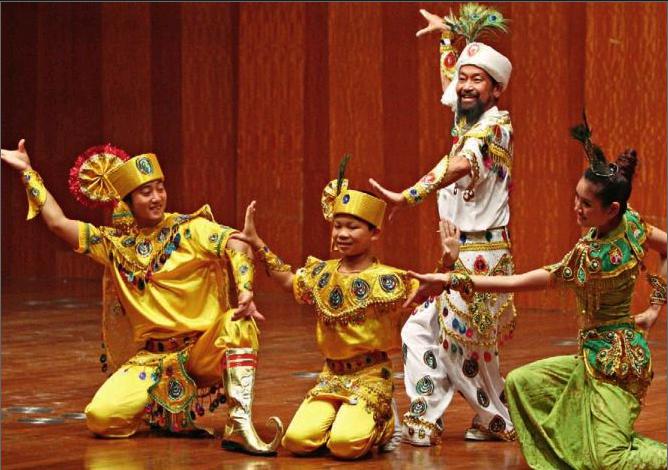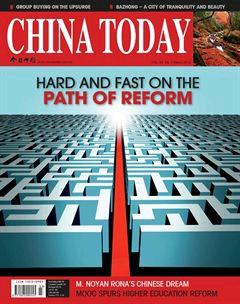Yue Xiang:Peacock Dance King
By+staff+reporter+JIAO+FENG

THE peacock dance is the most famous among the Dai folk dances. Since the most well renowned dancers of the style, such as Dao Meilan and Yang Liping, are female, many people often mistakenly associate the art form only with female dancers. However, in Yunnan Province, the indigenous center of the Dai peacock dance, the dance has traditionally been performed by males who display masculinity and a primitive vitality.
In his home village of Hansha, Yue Xiang often performs the peacock dance against a backdrop of beautiful Dai bamboo constructions, under banyans and to the beat of xiang jiao gu (elephant foot drum).
Professor Peacock
It is not difficult to find Yue Xiangs abode – two colorful peacocks painted on the gate posts of his yard can be seen clearly from afar. Inside his courtyard, on the wall of the left-hand side is a richly colored picture of groups performing the peacock dance. Yue Xiang looks much younger than his age, probably because of his regular dance training. His slim figure and bushy beard give him the demeanor of a transcendent being. Yue Xiang is a big name in the Dai area, as well as in northern Myanmar.
Yue Xiang owns three peacocks. They stroll around his courtyard, elegantly and proudly. When their owner greets them, they chirp in reply, but strangers go largely ignored. Yue Xiang once had seven peacocks at a time. The first lesson to his students always starts by observing the peacocks for one month. “Strictly speaking, we learn from the peacocks,” Yue Xiang explained. He believes that the bird itself is the best teacher for all peacock dance performers.
The primitive tropical forests in Yunnan are the peacocks natural habitats. The bird is sacred in Dai culture, a symbol of beauty, kindness, wisdom and auspiciousness. Age-old worshipping of peacocks is said to be the origin of the dance. Respecting peacocks as they do, the Dai people express their best wishes and give thanks for a happy life through the peacock dance. Yue Xiang confidently claims his rendition to be the most primitive form of the dance, since it was the bird itself that first taught him the moves.
Like all Dai people, Yue Xiang grew up with the peacock dance. As a child, he was attracted to the lively dance and the beat of the elephant foot drum. At the age of seven, Yue Xiang began to help sustain his familys livelihood by taking the cattle out to graze. Deep in the mountains, he often had the chance to see peacocks in the wild. Unlike other boys who were happy just collecting feathers, Yue Xiang often hid himself to observe peacocks at closer quarters. He recalls one such time when he saw a peacock flutter down to the riverbank to sip water. It was looking at its own reflection and combing its feathers, as if admiring itself in a mirror. Later, more peacocks came. They sang, ran around and spread their beautiful tails into iridescent fans. Yue Xiang knew this show was like a peacock gala in which they exhibited their nature and spirit.
During those years of herding cattle, Yue Xiang saw hundreds of peacocks. He imitated how they walked and spread their wings and tails. As he grew older, Yue Xiang noticed more and more details of the peacocks movements. This childhood experience made a strong impression. “The images of the birds come to my mind whenever I dance,” Yue Xiang said. He learned the most graceful postures from peacocks in his youth.
Amateur Dancer
Though he loves dancing, today, Yue Xiang works on farms and in the fields, just like his fellow villagers. He makes a living on planting rice and sugarcane, so in a sense, dancing is just a hobby for him. “We cant make a living from dancing; farming, on the other hand, puts food on the table,” he said.
The peacock dance is performed on almost all festive occasions. Dance lovers in the village often gather to exchange ideas and appraise the performers dancing skills. Yue Xiang feels that, even though they have to tend their farms every day, when there is a performance of the dance, the local farmers are transported to a land of dreams because they truly love this art. Yue Xiang views the dance as a tradition that Dai people have passed down for generations and can never abandon.
Yue Xiang herded cattle for his family until he was 24 years old. In those years, whenever he was alone, he would mimic the way peacocks drank, ate, washed and preened their feathers. If they caught him in the act, villagers often wondered whether he was of sound mind! So, to spare his embarrassment, the shy boy would do his peacock exercises late at night or before dawn, or find an area where no one could see him except his cows.
He took to the stage in the 1970s and gradually, made his name as a young peacock dance performer. Although his first master was the bird itself, Yue Xiang soon realized that it would be necessary to learn from real dancers if he wanted to raise his game – the arts are created by humans after all.“Peacocks are emotionally reserved. But the choreography of the dance can be intricate and varied,”Yue Xiang explained.
On a training course in the early 1980s, Yue Xiang encountered the most celebrated master of the art, Mao Xiang, who taught Dao Meilan, a peacock dancer with an international reputation. He began to seek advice from Mao Xiang.
Under Mao Xiangs guidance, Yue Xiang better understood the old Chinese sayings, “One minute on stage requires 10 years of practice off stage” and,“The master teaches the trade, but the apprentices skill is self-made.” Bearing the teachers advice in mind, Yue Xiang often pondered and practiced independently. “In my opinion, the peacock dance comes from inside. Every dancer can do the same move, like this one,” Yue Xiang shook his shoulders,” which imitates the peacock shaking its feathers. But the move will vary from dancer to dancer since it should come from our hearts.”
In 1986, a nervous but excited Yue Xiang made his debut on the national stage as part of a peacock dance troupe. One year later, he performed solo on the same stage. The primeval choreography and drumbeats appealed to the audiences and he won second prize in the national folk dance competition,gaining considerable fame in his hometown and being lauded as the Peacock Dance King.
Standing Out
Yue Xiang has put on performances all over the country and attracted a large number of dance fans who acknowledge him as their mentor. However, Yue Xiang often says modestly, “Many of my peers are able to do this dance just as well. What makes me stand out is that I was lucky enough to have had the opportunity to observe more, learn more and create more.”
Practicing peacocks movements has become an essential part of his life for over 50 years. Every morning, he exercises, first shaking his shoulders imitating the bird shaking its feathers and then mimicking the birds pecking movements. He makes a peacocks head with his fingers and pecks, presenting the agility of the bird.
Yue Xiang has also choreographed his own sig- nature move, which is quite challenging: He shakes his shoulders, turns around, poses, half squats, then turns and stretches one leg. Despite being in his sixties, his leg movements are swift and the gestures graceful.
As well as innovations in choreography, the Peacock Dance King has contributed a lot to the creation of peacock boxing. It was in 1982 on the occasion of the Ethnic Minority Games, that he started to think about what kind of sport could best represent the Dai ethnic group. Inspired by snake boxing and mantis boxing created by the Han people, Yue Xiang decided to integrate the peacocksmovements with traditional Dai boxing, thus creating peacock boxing.
Strength as well as grace is embodied in peacock boxing. When stretching out the arms and fists, ones body must form three curves, which enhance ones flexibility. The movements in peacock boxing exercise the joints in the whole body. The sport also requires its practitioners to make their eye movements match each physical movement. In 1999, Yue Xiang won fi rst place in a peacock boxing competition.
Preserving the Dance Legacy
With the aim of passing down Chinese cultural heritage to later generations, Yue Xiang has taught his sons and grandchildren the dance and led them to present performances. He specifically choreographed a special duo dance in which his grandson and granddaughter played a peacock and peahen. No doubt inspired by their grandfather, these two grandchildren are professional dancers, the grandson at the Ruili Ethnic Song and Dance Ensemble and the granddaughter at a dance center in Kunming, the capital of Yunnan Province.
Yue Xiang is keen to pass on his skills to anyone who wants to learn from him, without exception. He has built a simple studio with a stage in his courtyard to offer dance lessons; classes are taught on the second fl oor of a two-story bamboo building, while a good number of photos and commendations hang on the walls downstairs. His house is particularly busy during the summer vacation when parents bring their children to him to learn the dance.
An expert once remarked that the most praiseworthy quality of a cultural custodian was to have cultural self-awareness. Yue Xiang has been protecting Chinese culture from his home as an integral part of his daily life. More importantly, his activities and performances are neither for commercial gain nor for personal fame. He is passing on cultural heritage in the most natural way - giving performances and lessons when visitors come to watch and learn, getting on with making a living the rest of the time. His approach may be one of the clearest demonstrations of art in its purest form, and one of the overriding reasons why the peacock dance should be preserved in this way.

